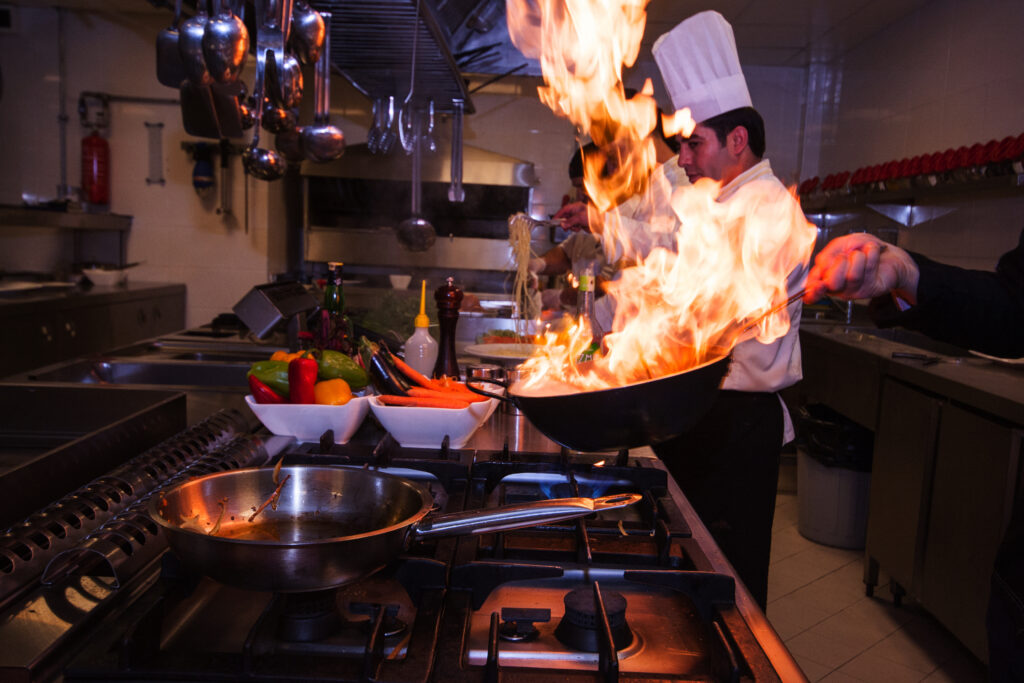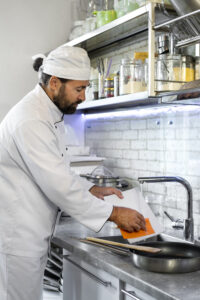What is food safety?
Food safety is a paramount concern in foodservice industry, it goes beyond preventing foodborne illnesses, and it also encompasses safeguarding customers from physical food hazards. These hazards can range from foreign objects like glass or plastic to accidents caused by improper food handling.
In this article, we’ll delve into the vital practices that food workers in food service industry should adhere to in order to prevent physical food hazards and ensure the well-being of diners.

1. Ensuring Proper Food Handling and Preparation:
- Emphasizing Hand Hygiene: Prioritize the importance of thorough hand washing before any food handling.
- Utensil and Equipment Sanitization: Train staff to consistently use clean and sanitized utensils, cutting boards, and equipment.
- Cross-Contamination Prevention: Implement stringent guidelines for segregating raw and cooked foods to mitigate the risk of cross-contamination.
2. Inspecting and Cleansing Ingredients:
- Vigilant Inspection: Teach food workers to meticulously inspect food items for any foreign objects or contaminants.
- Produce Purity: Stress the significance of comprehensive rinsing and cleaning of fresh produce to remove potential contaminants like chemical hazards
3. Safe Food Storage:
- Temperature Control: Highlight the importance of storing food at precise temperatures to inhibit spoilage and bacterial growth.
- Labelling and Dating: Implement a labelling and dating system to ensure proper food rotation and reduce the chances of serving expired or spoiled food.
4. Proper Food Packaging:
- Packaging Expertise: Educate staff on the use of suitable packaging materials to prevent damage or contamination of food items.
- Regular Inspection: Encourage routine inspections of packaging materials to detect any signs of damage.
5. Promoting Safe Cooking Practices:
- Temperature Precision: Establish clear cooking guidelines, ensuring food reaches recommended internal temperatures to eliminate harmful bacteria.
- Thermometer Usage: Advocate for the regular use of food thermometers to verify that the desired temperature is consistently achieved.
- Texture Consistency: Discourage overcooking, which can lead to undesirable hard or sharp food textures.

6. Preventing Broken Glass or Plastic Mishaps:
- Careful Handling: Train staff to handle glassware and plastic containers with utmost care to prevent breakage and food contamination.
- Regular Inspection: Instruct employees to routinely check glassware for any cracks or chips and safely dispose of damaged items.
7. Ensuring Safe Food Service:
- Server Training: Provide servers and wait staff with comprehensive training on safe food handling and service to minimize accidents.
- Transportation Precautions: Encourage the use of trays or serving carts when transporting multiple dishes to reduce spill risks.
8. Regular Equipment Maintenance:
- Maintenance Emphasis: Emphasize the significance of regular equipment maintenance to prevent accidents.
- Structured Maintenance: Create a maintenance schedule and conduct routine inspections of kitchen equipment to promptly identify and address potential hazards.
9. Thorough Cleaning and Sanitizing:
- Cleaning Protocols: Stress the need for systematic cleaning and sanitization of food preparation surfaces and equipment.
- Maintenance Schedule: Implement a comprehensive cleaning checklist and schedule to ensure cleanliness and safety.

10. Continual Staff Training:
- Ongoing Education: Provide comprehensive and ongoing training on food safety practices to all employees.
- Refresher Sessions: Conduct periodic refresher training sessions to reinforce safe practices and knowledge.
11. Promoting Reporting and Issue Resolution:
- Cultivating a Reporting Culture: Foster a work environment where all staff members feel comfortable reporting potential food hazards promptly.
- Swift Resolution: Develop a system for swift corrective action when issues are identified to prevent further harm.
12. Customer Awareness:
- Educating Diners: Educate customers about potential food hazards, such as bones in fish or pits in fruits, to help them avoid injuries.
- Providing Tools: Offer appropriate utensils or tools (e.g., seafood forks) to assist customers in safely enjoying their meals.
